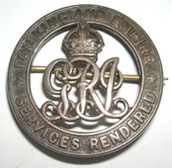Museum of the Manchester Regiment Object Focus
The Silver War Badge 
Did you know?
Some men received white feathers from members of the public who believed they were cowards for not joining British forces during the First World War (1914-1918).
Some who had been discharged from service also received white feathers as people could not always see why a man should not have been in uniform.
To prevent this, the Army Council authorised the Silver War Badge (also known as the Silver Wound Badge) in September 1916. They were used as proof that the wearer had served their country.
The award was issued to:
- Men who had served at least seven consecutive days after the 4 August 1914.
- Those that had retired or been discharged on account of their age.
- Those suffering from physical infirmity as a result of wounds caused other than by misconduct.
Each badge was uniquely numbered. These numbers can be researched by consulting the Silver War Badge Roll held at the National Archives, London.
The Silver War Badge was discontinued on the 31 December 1919. There had been 1,092,016 issued. 766,145 of these were awarded to Imperial troops.
A display of Silver War Badges can be seen in the First World War section of the Museum of the Manchester Regiment's Ladysmith Gallery.
Further Reading:
- http://en.wikipedia.org/wiki/Silver_War_Badge

- http://www.longlongtrail.co.uk/soldiers/how-to-research-a-soldier/campaign-medal-records/records-of-the-silver-war-badge/

This article was researched and compiled by Sam Thomas while on placement at the Museum of the Manchester Regiment, May 2009.

